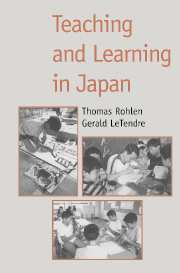Book contents
- Frontmatter
- Contents
- List of contributors
- Introduction: Japanese theories of learning
- Section I Fundamental approaches
- Section II The emotional foundations of early learning
- Section III School and classroom models
- Section IV Path and guidance
- Section V Artistic pursuits – old and new
- Conclusion: themes in the Japanese culture of learning
- References
- Index
Conclusion: themes in the Japanese culture of learning
Published online by Cambridge University Press: 05 June 2012
- Frontmatter
- Contents
- List of contributors
- Introduction: Japanese theories of learning
- Section I Fundamental approaches
- Section II The emotional foundations of early learning
- Section III School and classroom models
- Section IV Path and guidance
- Section V Artistic pursuits – old and new
- Conclusion: themes in the Japanese culture of learning
- References
- Index
Summary
There is no single stereotypical experience that defines the Japanese process of learning, but as we have seen, there are many themes that appear in the various contexts we have been considering. Together these make larger patterns of practice that one encounters frequently when looking closely at learning and teaching in Japan. The preceding essays have presented a rich variety and raised many questions about how such variety is to be understood. In this Conclusion, we highlight the underlying patterns that organize the diversity – the unifying themes, contradictions, complementarities, discontinuities, and challenging issues before Japan. These constitute key aspects of the temporal and spatial dimensions of a landscape of learning and teaching.
Put another way, certain expressions or models of learning or teaching in Japan evoke expectations, patterns, and associations that are identifiable across situations. Within these patterns, both teachers and learners express themselves in terms of certain ideal concepts that shape an inherent dialogue and guide attention to shared expectations.
Play
Much of Shinto ritual is about play (asobi) as entertainment for the gods, just as play is a natural avenue for growth and vitality in the teaching approach to early education. Along with the notion of just letting the child grow, there is the notion that in the early years, children should just play. Asobi has connotations of unstructured, renewing activity – activity with a creative or energizing potential. This focus on allowing natural energies to flow freely and strongly is part of very old ideas about learning as well as health.
- Type
- Chapter
- Information
- Teaching and Learning in Japan , pp. 369 - 376Publisher: Cambridge University PressPrint publication year: 1996
- 8
- Cited by

